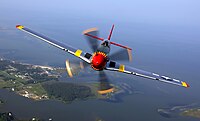
Photo from wikipedia
Abstract In the present work, computational fluid dynamics simulation was carried out using ANSYS Fluent to study the performance of conventional and tapered turbine blades for hydrokinetic power generation. The… Click to show full abstract
Abstract In the present work, computational fluid dynamics simulation was carried out using ANSYS Fluent to study the performance of conventional and tapered turbine blades for hydrokinetic power generation. The sliding mesh technique is used to study the influence of taper on conventional Savonius turbine using the SST k-ω turbulence model and performance parameters were determined. The geometric parameters used in the present simulation for conventional and tapered turbine blades are aspect ratio and overlap ratio of 1.0 and 0.0. The inlet velocity and depth of water used for present simulation are 0.5 m/s and 103.6 mm for both conventional and tapered turbine blades. The results show that a 5% increase in the performance of a conventional turbine as compare to tapered turbine blade with a taper angle of 5°. The value of maximum coefficient of power for conventional Savonius turbine blade is 0.21 with a tip speed ratio 0.9. The flow field around the conventional and tapered turbine blades at different angular positions are analysed. It was found that there is a loss of energy at the exit side of the advancing blade for the case of tapered turbine, that leads to 5% reduction of performance as compared to the conventional turbine.
Journal Title: Sustainable Energy Technologies and Assessments
Year Published: 2020
Link to full text (if available)
Share on Social Media: Sign Up to like & get
recommendations!